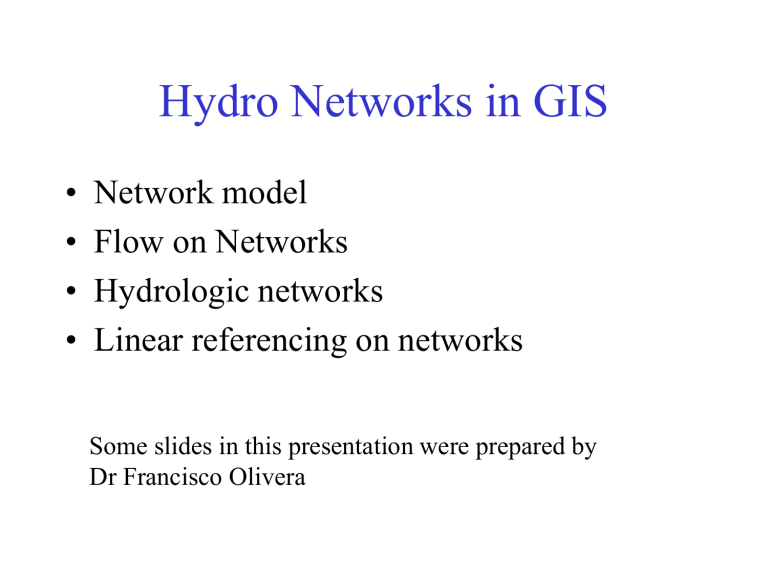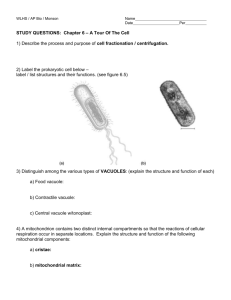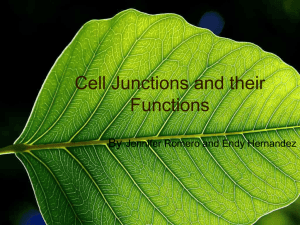Hydrographic Network

Hydro Networks in GIS
• Network model
• Flow on Networks
• Hydrologic networks
• Linear referencing on networks
Some slides in this presentation were prepared by
Dr Francisco Olivera
Desktop
ArcGIS Resource Centers http://resources.arcgis/com
Getting to Readings in
ArcGIS Resource Center
Help for Desktop 10
Help
Reading (1)
ArcGIS Resource Center/Desktop 10/Help/Professional Library/Data
Management/Geographic Data Types/Geometric Networks – What are geometric networks, A quick tour of geometric networks, Essential geometric networks http://help.arcgis.com/en/arcgisdesktop/10.0/help/index.html#/What_are_geometric_networks/002r00000001000000/
Reading (2)
ArcGIS Resource Center/ Desktop 10/Help/Professional Library/Guide books/Linear Referencing
- What is linear referencing; Essential linear referencing http://help.arcgis.com/en/arcgisdesktop/10.0/help/index.html#/What_is_linear_referencing/003900000001000000/
Key Concepts from Exercise 4
• DEM Reconditioning as an example of quantitative raster analysis
– Vector to Raster
– Distance
– Raster Calculation
– Volume removed analysis
Subtract 10 at all stream grid cells
"smdem" - 10 * “flowLineReclas" - 0.02 * (500 - "distance") * ("distance" < 500)
500 500
10
10
Subtract an amount that tapers from 0.02*500=10 when distance is 0, to 0 when distance is 500 from stream
Only do taper when distance is less than
500, otherwise this is 0 and nothing is subtracted
3D Analyst Profiles smrecon smdem diff
Construct the Analysis Layer
•
Fill
•
Flow Direction
•
Flow Accumulation
•
Stream Definition
•
Stream Links
•
Catchments
Convert to Vector
• Vector streams
• Vector catchments
• Attribute feature with raster zonal statistics
• Geometric Network
• Tracing
• Selection statistics
Raster to Vector Transition
• During the last week, you have been dealing with the flow of water through the landscape based on the raster data structures
• Today we are making a transition in which we are going to use vector network data to describe water pathways.
• We will connect the land and water flow systems by attaching the catchments and watersheds derived from raster data processing to our vector networks
Four Key Concepts
• Four key constructs
– Cell to cell water movement on DEMs
– Line to Line water movement on networks
– Area flows to line
(connect land and water systems – Reach
Catchments)
– Area flows to point on line (Watershed delineation from designated points)
Cell Flows to a Cell
Core concept of flow on digital elevation models
Line Flows to a Line
Geometric Network of NHDFlowlines
Area Flows to a Line
Reach Catchments from NHDPlus
Flowline and Catchment have the same COMID
Area Flows to a Point on a Line
Watersheds for USGS Gages
Network Definition
• A network is a set of edges and junctions that are topologically connected to each other.
Network Model in GIS
• Three components
– Geometric model:
(x,y,z,m) coordinates of edges and junctions
– Logical model: which edges are connected to what junctions
– Addressing model: location on the network using measure
Edges and Junctions
• Simple feature classes: points and lines
• Network feature classes: junctions and edges
• Edges can be
– Simple: one attribute record for a single edge
– Complex: one attribute record for several edges in a linear sequence
• A single edge cannot be branched
No!!
Polylines and Edges
Junctions
• Junctions exist at all points where edges join
– If necessary they are added during network building ( generic junctions )
• Junctions can be placed on the interior of an edge e.g. stream gage
• Any number of point feature classes can be built into junctions on a single network
Connectivity Table
J125
Junction Adjacent Junction and Edge
J123 J124 , E1
J124
J125
J126
J123 , E1 J125 , E2 J126 , E3
J124 , E2
J124 , E3
J123
J124
E1
This is the “Logical Network”
E2
E3
J126
Build Network Tables
• Establishes connectivity of
Edge and
Junction features
• Enables tracing
• Generates
Generic Junctions
Geometric Network Wizard in ArcCatalog
Snapping Features
Network Sources and Sinks
Each junction feature class in a network can have junctions which are sources or sinks for flow
Use complex edge so that junction can be interior to edge
Flow to a sink
Flags
Trace Solvers
Upstream Trace Solvers
Hydrologic Networks
• Hydrologic data includes:
– Single-line streams
– Double-line streams
– Braided streams
– Manmade channel systems
– Waterbodies
Flow Line
Traces movement of water in a one-dimensional flow system
Location of the Flowline
Introduction to the Hydro Network
• Hydro Edge – think of Arc
• Hydro Junction
– think of Node
• Waterbody – think of Polygon
Flow Network
A connected set of flow edges
Edge
Junction
Network Building
• Define flow-paths within double-line streams and waterbodies.
• Define network sinks and sources.
Network Connectivity
Find connected Find loops
Network Flow Direction
• Enable flow in flow-paths.
• Disable flow in shorelines
Sink
Flow direction is unknown
Network Flow Direction
• Enable flow in flow-paths.
• Disable flow in shorelines
Sink
Flow direction is known
Uninitialized Flow Direction
Assigned Flow Direction
Network Tracing
Trace Upstream Trace Downstream
Trace Path
Find the shortest path between two points on the network
Hydro Network for Holland
Hydro Network for Colorado
River Basin around Lake Travis
Network Tracing on the Guadalupe Basin
Some terminology
• Hydrography – the mapping of water features
• Blue line features on topographic maps (streams, rivers, lakes,…)
• More generally, hydrography also includes the mapping of bathymetry and extent of estuaries and coastal waters
• National Hydrography Dataset (NHD) – a data model for storing topographic map hydrography
– Medium resolution (1:100K) is complete for US
– High resolution (1:24K) is complete for most of the US
• NHDPlus – a new data model integrating 1:100K resolution NHD with catchments and derived attributes from the National Elevation Dataset
National Hydrography Dataset
Key feature classes
Five feature classes with
NHDFLowline built into
A geometric network
NHDPoint, NHDLine,
NHDArea are point, line and area water features on map apart from flowlines and waterbodies
National Hydrography Dataset
NHD Waterbody
NHD Geometric Network
NHDPlus Reach Catchments ~ 3km 2
Average reach length = 2km 2.3 million reaches for continental US
About 1000 reach catchments in each 8-digit HUC
Reach Attributes
• Slope
• Elevation
• Mean annual flow
– Corresponding velocity
• Drainage area
• % of upstream drainage area in different land uses
• Stream order
United States Experience with DEM
Improvement
1990’s
5%
Error in delineated watershed area
0.5% 2000’s
1 arcsec: 30 m 3 arcsec: 90 m
DEM Cell Size
National Elevation Dataset for Australia
Existing New
9 Arc Second – 250 m 1 Arc Second – 30 m
1 cell 81 cells
Two orders of magnitude improvement! Wow!
Images: John Gallant, CSIRO
National River Network for Australia
Line flows to Line
Geometric Network
•
Geometry model: Where am I? (x,y coordinates)
•
Logical model: Who am I connected to? (topology)
•
Addressing model: Where are things on me? (linear referencing)
Image: Elizabeth McDonald, BoM
A challenge: those messy Aussie rivers have lots of loops and branches
Image: Michael Hutchinson, ANU
A fundamental innovation:
Connecting the Cell to Cell and Line to Line Models
Flow divergences have multiple flow directions on a single DEM cell
Cell flows to Cell
Image and Research: Janet Stein, ANU
Reach Catchments
Every stream reach has a local drainage area
Area flows to Line
Image: Elizabeth McDonald, BoM
Fundamental connection between the water and land systems
Contracted Nodes and Catchments
A standardized tessellation of the landscape – one chosen among the infinite number of tessellations possible
Contracted Nodes Contracted Catchments
Area flows to a point on a line
Contracted nodes persist through successive versions of the geofabric
Images: Elizabeth McDonald, BoM
Linear Referencing
Where are we on a line?
Addressing
Coordinates of a 2-D Polyline
Coordinates of a 2-D Polyline M
Setting Line Measure
Proportional Aliasing
Distance is measured
Relative to the length of the line as a percentage
0% – 100%
Setting Percent Measure pMSeg.SetAndInterpolate
MsBetween 0, 100
0 – 100 going upstream pMSeg.SetAndInterpolate
MsBetween 100, 0
0 – 100 going downstream
Point and Line Events
Summary Concepts
• Four key constructs
– Cell to cell water movement on DEMs
– Line to Line water movement on networks
– Area flows to line
(connect land and water systems – Reach Catchments)
– Area flows to point on line
(Watershed delineation from designated points)
Summary Concepts (2)
• A network is a connected set of points
(junctions) and lines (edges) that supports tracing functions
– Three data model components
• Geographic (x,y,z)
• Logical (point-line topology connections)
• Addressing (position m along the line)
Summary Concepts (3)
• Linear referencing can be used to locate point and line “events” on a network
• This is like
(x,y) event themes that you used earlier to map stream gage locations in geographic space





